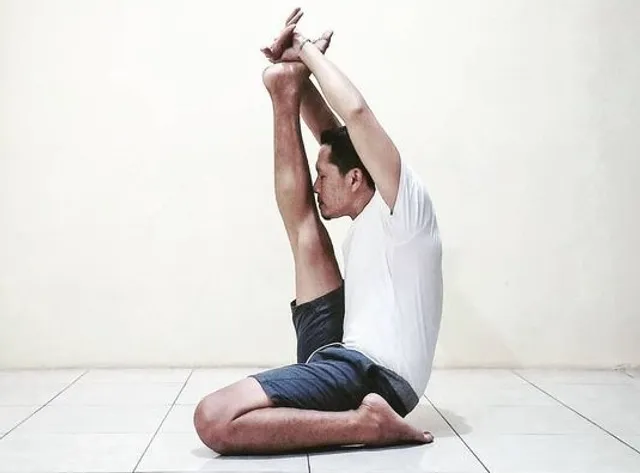
KROUNCHASANA, the posture of the heron
This posture is a variant of Triang Mukha Eka Pada Paschimottanasana. It has the benefits of a backward extension on the front of the leg on the floor and those of a forward extension on the raised leg like Hanumanasana but it is safer on the hamstrings because it is the student who manages the intensity of the posture and not the gravity which helps the stretching. Krounchasana is an excellent posture for stimulating the abdominal organs, stretching the lower back, legs and abdomen.
This pose also helps heal from mild depression, increases willpower, and helps stay grounded.
Krounchasana stimulates the chakra manipura, the solar plexus which is represented by a lotus flower with 10 yellow petals. This energy center is located about 3 fingers wide above the navel and radiates horizontally from front to back. This chakra associated with the mental body represents self-esteem, willpower, instinct, interpersonal relationships, outward contact and social identity. It is the place of sorting that distributes the energy to the other chakras. The solar plexus chakra is the initiator of the quality of relationships with others. Manipura also helps balance the management of food, thoughts and emotions that facilitate decision-making, self-esteem and self-confidence.
When the solar plexus chakra is balanced, the person has confidence in himself and has the will to achieve his goals. The subject is happy, warm, zen, open and spontaneous, he respects others and himself. His emotions flow smoothly and he doesn't care about his image.
On the other hand when the solar plexus is too open the subject is proud, conceited, rigid, perfectionist and preoccupied with work and diets. He lacks interest and attention in others and gets overwhelmed by emotions. When manipura is too closed, the subject does not know how to express his emotions, lacking combativeness, ambition and self-confidence. He needs the approval of others by ignoring his own desires because he is afraid of judgment. He easily gives up on his plans and is unable to face up to his responsibilities. All of this can cause digestive disorders, ulcers or even cancer.
If the grip can be done under the foot, it is in chin mudra (as in the bird of paradise) where the thumb and forefinger are tied. By closing the circle with the index finger and thumb, the yogi achieves the union of the human soul with that of the Universe. The Chin Mudra which evokes the spiritual consciousness, makes it possible to drive out the negative to make room for the yogic consciousness, it is recognized for its benefits on the physical and the mental. This hand gesture amplifies the benefits of posture by improving the fluidity of the digestive system and soothing its disorders, it helps to better manage behavioral disorders, fight anger and stress and improve memory.
Access the annotated class sequence with posture images and join the community of teachers!